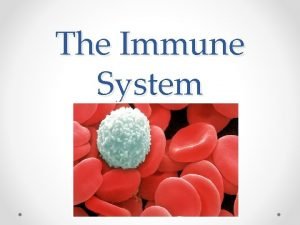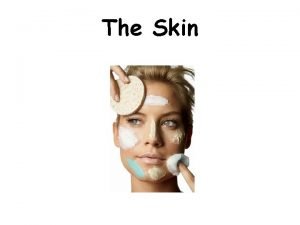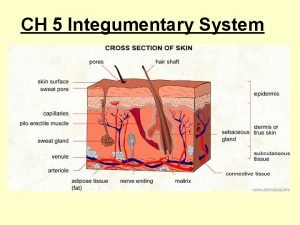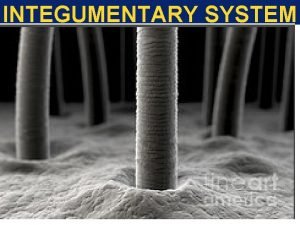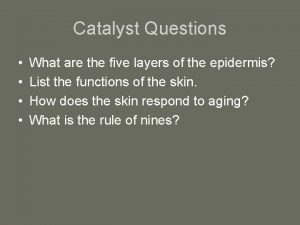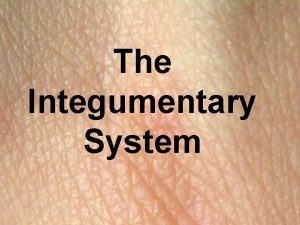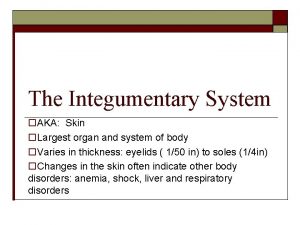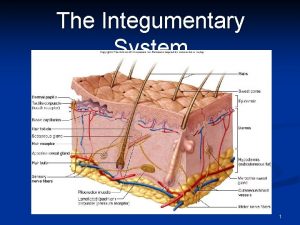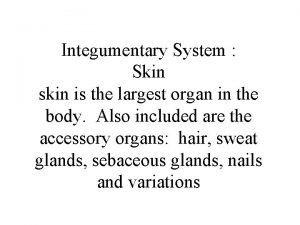Integumentary System Chapter 6 Integumentary System Largest organ











































- Slides: 43

Integumentary System Chapter 6

Integumentary System Largest organ in the body is the skin Skin + Hair + Nails + Sensory Receptors + Glands = INTEGUMENTARY SYSTEM! The skin forms a barrier between us and the outside

Skin and Its Tissues The skin has 2 layers: Epidermis—stratified squamous Dermis—connective, smooth muscle, and nervous tissue A basement membrane anchors the epidermis to the dermis

Skin and Its Tissues Just beneath the dermis is areolar tissue and adipose tissues—bind the skin to the organs below These tissues are called subcutaneous layer Adipose tissue insulates and conserves body heat Subcutaneous layer contains major blood vessels

Botox Anyone? “Botox” is a treatment to temporarily remove facial wrinkles Very dilute solution of botulinum toxin (Clostridium botulinum, which causes food poisoning) Blocks nerve activation of certain muscles in the face Not a permanent blocker

https: //www. youtube. com/watch? v=D-Ol 9 ALZg. Js The Patch Some drugs are introduced through transdermal patches—contain a reservoir of the substance The drug diffuses into the epidermis and enters blood vessels in the dermis Motion sickness, blood pressure, nicotine, caffeine, birth control

Epidermis Entirely made of stratified squamous cells Lacks blood vessels Deepest layer is called the stratum basale As cells in this layer divide and grow, the older cells are pushed away from the dermis toward the surface

Epidermis As the older cells get further from the dermis, they have less blood supply, so they die Older cells are called keratinocytes—harden in a process called keratinization The cytoplasm fills with waterproof keratin proteins Many layers of tough, tightly packed dead cells accumulate in the outer layer of the epidermis—stratum corneum

Epidermis Between the basale and corneum there are 3 layers (from deepest to superficial): 1. Stratum spinosum 2. Stratum granulosum 3. Stratum lucidum only present in the palms and soles


Epidermis Calluses are caused by an increased rate in cell division where the skin is rubbed or pressed regularly Epidermis shields most underlying tissues against excess water loss, injury, and effects of harmful chemicals

Epidermis Melanocytes (contain melanin) provide skin color The more melanin, the darker the skin color Melanin absorbs UV radiation in sunlight—without melanin UV could cause mutations in the DNA of skin cells Melanocytes are found deep in the epidermis (stratum spinosum)

Dermis The boundary between the epidermis and the dermis is uneven because of epidermal ridges and dermal papillae

Dermis Dermal papillae are found all over the body, but are concentrated in the hands and feet The ridges formed by the papillae are what makes our fingerprints General fingerprints are determined by genes

Why doesn’t everyone have the same fingerprint? The skin ridges are altered as a fetus presses the hands and feet against the uterine wall Because no two fetuses move the same way, no two people have the same fingerprints EVEN IDENTICAL TWINS!

Dermis The dermis binds the epidermis to the subcutaneous layer Composed of areolar tissue and dense connective tissue Dermal blood supplies nutrient to all skin cells Help regulate body temperature

Nails Hair and nails are both made of keratin! Protective covering at the end of all fingers and toes 5 Parts Cuticle—skin at the base of the nail plate Nail plate—nail you can see Nail bed—skin under the nail Free Edge—end of the nail Lunula—white half moon at the bottom of the nail Most actively growing region of the nail


Hair is present on all skin surfaces except the palms, soles, lips Each hair develops from cells at the base of a tubelike depression called a hair follicle The follicle contains the hair root (can extend through the dermis into the subcutaneous layer)

Can you hair me? ? The deepest part of the root is called the hair bulb— epithelial cells nourished by dermal blood vessels As the epithelial cells grow, older cells are pushed toward the surface—they become keratinized and die The remains of these cells make up the hair shaft

Hair Accessories Smooth muscle cells called the arrector pili muscle attaches to each hair follicle When the muscle contracts, the hair stands on end The contracted muscle causes a bump on the skin “goosebumps”

Skin Glands Sebaceous glands—oil glands Sweat glands Eccrine glands—respond to elevated body temperature; abundant on the forehead, neck and back produce sweat on hot days/during activity; release moisture on the palms and soles when a person is emotionally stressed

Skin Glands Sweat Glands Apocrine glands—become active during puberty; secrete when a person is emotionally upset, frightened, in pain, or sexually aroused; most common in axillary and groin regions; secretions include proteins and lipids that produce body odor when metabolized by bacteria Eccrine sweat glands are free standing structure, Apocrine sweat glands are attached to hair follicles

In 1 square inch of skin, there are…


Can you name structures 1 -4?

Damage to the Skin Puncture Caused by a sharp object that penetrates the skin May cause significant deep injury that is not immediately recognized Do not bleed freely

Damage to the Skin Laceration Most common type of open wound Commonly called cuts Irregular cut or tear through the skin

Damage to the Skin Abrasions Commonly called scrapes Occur when the skin is rubbed across a rough surface Involve variable depths of skin

Damage to the Skin Avulsion Tearing away of body tissue Raise flaps of tissue, usually along normal tissue planes The avulsed part may be totally severed from the body or it may be attached by a flap of skin

Burns Injury to the skin, or other tissues, caused by heat, cold, electricity, chemicals, friction, or radiation Threat to Life Catastrophic loss of body fluids Dehydration and fatal circulatory shock Infection

Burns Types First degree—epidermis; redness Second degree—epidermis & upper dermis; blister Third degree—full thickness of the skin


Skin Grafts Third degree burns require skin grafts Graft options: Autograft—from patient Temporary grafts: Isograft—from identical twin Homograft—unrelated person Cultured keratinocyte patches Amnion from afterbirth Heterograft—another species Artificial skin from silicon and collagen

Freckles Small areas of the skin that contain overactive melanocytes More common in fair skinned individuals

Acne forms when sebaceous glands are over active Excess oil and dead skin cells form a plug in the hair follicle Most common types are whiteheads and blackheads NOT associated with sweat glands!

White Heads When trapped oil and dead skin cells cause the hair follicle to bulge The “plug” in the follicle stays below the surface of the skin

Blackheads Trapped oil and dead cells are partially open to the surface of the skin Not actually dirt, but appear brown when the plug is exposed on the skin

Eczema Group of conditions that cause inflammation of the skin Causes skin to become itchy, red, and dry Can appear on any part of the body Not contagious Runs in families

Eczema Doctors don’t know what exactly causes eczema Current thinking is that eczema is caused by a combination of factors including: Genetics Abnormal functioning immune system Environment Activities that cause the skin to be more sensitive Defects in the skin barrier that allow moisture out and germs in

Moles Occur when melanocytes grow in a cluster as opposed to being spread out through the skin May darken after exposure to the sun, during the teen years, and during pregnancy

Moles 2 kinds of moles Congenital nevi—present at birth; occur in about 1 in 100 people; slightly more likely to develop into melanoma (cancer) Dysplastic nevi—generally larger than average and irregular in shape; uneven coloring

Melanoma? People who have 10 or more dysplastic nevi have a 12 times higher chance of developing melanoma Majority of moles are not dangerous The ABCDEs are important when examining moles: Asymmetry—one half of the mole does not match the other Border—The edges of the mole are ragged, blurred, or irregular Color—The color of the mole is not the same throughout Diameter—The diameter of the mole is larger than the eraser of a pencil Evolution—The mole is changing in size, shape, or color
 Cell tissue organ organ system organism
Cell tissue organ organ system organism Cells are the building blocks of all living things
Cells are the building blocks of all living things Organ and organ system
Organ and organ system Largest lymphoid organ
Largest lymphoid organ Skin is the largest organ
Skin is the largest organ Function of lymphatic system
Function of lymphatic system Stratum basale
Stratum basale You gotta have skin
You gotta have skin Which is the largest organ in our body? *
Which is the largest organ in our body? * Hepatic acinus
Hepatic acinus Bodys largest organ
Bodys largest organ Organ organ penyusun sistem pencernaan
Organ organ penyusun sistem pencernaan Tractus respiratorius
Tractus respiratorius Keratomalasi
Keratomalasi Unit 3 integumentary system a&p chapter 5
Unit 3 integumentary system a&p chapter 5 Chapter 6 integumentary system
Chapter 6 integumentary system Chapter 36 skeletal muscular and integumentary systems
Chapter 36 skeletal muscular and integumentary systems Glands in integumentary system
Glands in integumentary system Integumentary system vocabulary
Integumentary system vocabulary Fetal pig integumentary system
Fetal pig integumentary system Pengertian sistem integumen
Pengertian sistem integumen Integumentary system facts
Integumentary system facts Exercise 7 the integumentary system
Exercise 7 the integumentary system Integumentary system vocab
Integumentary system vocab Integument medical term
Integument medical term Integumentary system
Integumentary system Integumentary system assessment
Integumentary system assessment Excretory system analogy
Excretory system analogy Cat integumentary system
Cat integumentary system The integumentary system
The integumentary system Integumentary system components
Integumentary system components Effects of aging on the integumentary system
Effects of aging on the integumentary system Section 36-3 the integumentary system
Section 36-3 the integumentary system Integumentary system
Integumentary system Integumentary system
Integumentary system Homeostatic imbalance of the skin
Homeostatic imbalance of the skin Cells in stratum spinosum
Cells in stratum spinosum 6 functions of the integumentary system
6 functions of the integumentary system Integumentary system psoriasis
Integumentary system psoriasis Urinary system facts
Urinary system facts Integumentary system
Integumentary system Integumeny
Integumeny Integumentary system cpt coding guidelines ppt
Integumentary system cpt coding guidelines ppt Stratum basale
Stratum basale



